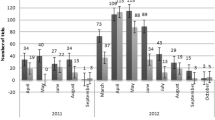Summary
A total of 691 Ixodes ricinus (22 male, 39 female, 501 nymphs and 129 larvae), the tick vector of Lyme borreliosis, were collected by flagging from vegetation in 11 areas at altitudes between 789 m and 1350 m above sea level in mixed woodland with pasture land (cattle) in the province of Styria in Austria. The ticks were individually examined for presence of Borrelia burgdorferi sensu lato by dark-field microscopy and 107 of them by real-time PCR. Attempts to cultivate borreliae were made in BSK-H medium. The overall positivity rate of all collected ticks (excepting larvae) was 10.9%: 9.1% in males, 17.9% in females and 10.4% in nymphs. The 129 larvae examined showed no presence of B. burgdorferi s.l. The mean infection rate of I. ricinus collected at the highest altitude in this study, Gaberl at 1350 m a.s.l. – and at the same time the highest one reported in Europe – was 6.4%: 1/9 males, 2/18 females and 6/114 (5.3%) nymphs were positive. Culture attempts were positive in 12 cases and species identification showed eight isolates were B. afzelii and four B. garinii. Three additional positive results found by PCR (negative by culture) were identified twice as B. afzelii and once as B. garinii. This study shows that the risk of acquiring Lyme borreliosis in habitats at higher altitudes is limited, because of the lower density of I. ricinus and its lesser infection rate than at lower altitudes in central Europe, but nevertheless the risk does exist.
Similar content being viewed by others
References
Stünzner D, Hubálek Z, Halouzka J, Postic D, Pierer K, Marth E (1998) Prevalence of Borrelia burgdorferi s.l. in Ixodes ricinus ticks from Styria (Austria) and species identification by PCR-RFLP analysis. Zbl Bakt 288: 471–478
Labuda M, Stünzner D, Kozuch O, Sixl W, Kocianova E, Schaffler R, Vyrostekova V (1993) Tick-borne encephalitis virus activity in Styria, Austria. Acta Virol 37: 187–190
Aeschlimann A, Chamot E, Gigon F, Jeanneret J-P, Kesseler D, Walther C (1986) B. burgdorferi in Switzerland. Zbl Bakt Hyg A 263: 450–458
Miserez V, Gern L, Aeschlimann A (1990) Borrelia burgdorferi in ticks of the Canton Tessin (Switzerland). Parassitologia 32: 293–299
Jouda F, Perret JL, Gern L (2004) Ixodes ricinus density, and distribution and prevalence of Borrelia burgdorferi sensu lato infection along an altitudinal gradient. J Med Entomol 41: 162–169
Burri C, Morán F, Douet V, Humair P-F, Moret J, Gern L (2005) Ixodes ricinus density and infection prevalence of Borrelia burgdorferi sensu lato along a north facing altitudinal gradient in the Swiss Alps (Rhone valley, Valais, Switzerland). 5th International Conference on Ticks and Tick-borne Pathogens, Neuchatel, 29.8.–2.9.2005, Abstracts: 19
Pietilä J, He QS, Oksi J, Viljanen MK (2000) Rapid differentiation of Borrelia garinii from Borrelia afzelii and Borrelia burgdorferi sensu stricto by light Cycler fluorescence melting curve analysis of a PCR product of the recA gene. J Clin Microbiol 38: 2756–2759
Postic D, Assous MV, Grimont P, Baranton G (1994) Diversity of Borrelia burgdorferi sensu lato evidenced by restriction-fragment-length-polymorphism of rrf (5S) rrl (23S) intergenic spacer amplicons. Int J Syst Bact 44: 743–752
Hubálek Z, Halouzka J (1998) Prevalence rates of Borrelia burgdorferi sensu lato in host-seeking Ixodes ricinus ticks in Europe. Parasitol Res 84: 167–172
Daniel M, Danielová V, Kríž B, Jirsa A, Nožicka J (2003) Shift of the tick Ixodes ricinus and tick-borne encephalitis to higher altitudes in Central Europe. Eur J Clin Microbiol Infect Dis 22: 327–328
Daniel M, Danielová V, Kríž B, Kott I (2004) An attempt to elucidate the increased incidence of tick-borne encephalitis and its spread to higher altitudes in the Czech Republic. Int J Med Microbiol 293 [Suppl 37]: 55–62
Zeman P, Beneš Č (2004) A tick-borne encephalitis ceiling in Central Europe has moved upwards during the last 30 years: possible impact of global warming? Int J Med Microbiol 293 [Suppl 37]: 48–54
Materna J, Daniel M, Danielová V (2005) Altitudinal distribution limit of the tick Ixodes ricinus shifted considerably towards higher altitudes in Central Europe: results of three years monitoring in the Krkonoše Mts. (Czech Republic). Centr Eur J Publ Hlth 13: 105–122
Author information
Authors and Affiliations
Corresponding author
Rights and permissions
About this article
Cite this article
Stünzner, D., Hubálek, Z., Halouzka, J. et al. Prevalence of Borrelia burgdorferi sensu lato in the tick Ixodes ricinus in the Styrian mountains of Austria. Wien Klin Wochenschr 118, 682–685 (2006). https://doi.org/10.1007/s00508-006-0695-x
Issue Date:
DOI: https://doi.org/10.1007/s00508-006-0695-x




